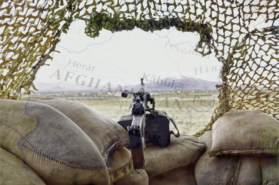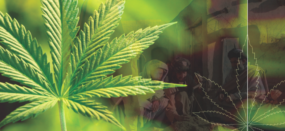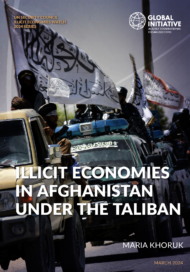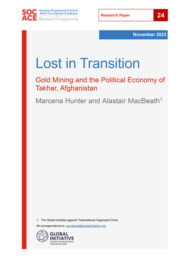Posted on 17 Feb 2025
In 2022, Afghanistan accounted for roughly 80 per cent of the world’s opiate supply and was a major global exporter of opium and heroin. But in April that year, the newly installed Taliban regime announced a ban on poppy cultivation and all types of narcotics, leading to plummeting levels of production. Immediately following the ban, international observers predicted a total disruption of global heroin supply chains, and questions were raised about the ban’s sustainability, its impact on the Afghan population and its effect on Afghanistan’s growing methamphetamine production. With the ban soon to enter its fourth year, it is time to take stock of the real impact it is having on Afghanistan’s illicit drug economy.
A slow return to the status quo?
While opium poppy cultivation in Afghanistan did not cease completely after the ban, the market was severely disrupted. By pressuring farmers to stop growing opium poppy and carrying out a targeted eradication campaign, the Taliban succeeded in drastically reducing cultivation. The change was particularly apparent in the south-western provinces, which had previously been the heart of opium farming. The drop in cultivation caused prices to soar.
However, limited cultivation still continued: some farmers replanted poppy where crops had been destroyed, and others relocated to remote areas away from Taliban control, such as the northern province of Badakhshan or the Balochistan region in Pakistan. The Taliban also avoided widespread popular opposition to the ban by granting a two-month reprieve for the 2022 autumn harvest. The opium collected was thus added to the already substantial stockpiles built up over several years of abundant harvests. With cultivation drastically reduced, these stockpiles continued to supply opium to demand markets, allowing landowners and traffickers to profit from the high prices.
After peaking at the end of 2023, opium prices began to decline, potentially pointing to a steady supply. Later that year, the UN Office on Drugs and Crime recorded the first significant increase (by almost a fifth) in opium cultivation in Afghanistan since the announcement of the ban, largely due to poppy cultivation in the north-east. Cultivation also occurred in Pakistan, reversing the historical import–export dynamic between the two countries, where Afghan opium was exported to Pakistan.
Fieldwork in Afghanistan in 2024 found that the sale of opium continued unabated and had even become more ubiquitous. While notorious ‘drug bazaars’ had been closed down, vendors had begun to sell opium alongside food and other common products in legal markets, operating with the tacit approval of the authorities.
It is likely that the continued availability of opium has prevented the dramatic increase in the trade in Afghan methamphetamine that the international community had anticipated. In the long term, however, the methamphetamine trade may prove more resilient to the Taliban’s ban: the drug is made from the ephedra shrub, which grows abundantly in Afghanistan, laboratories are relatively simple and inexpensive to set up, and, if destroyed, can be quickly rebuilt elsewhere. In fact, the methamphetamine industry has responded to the threat of disruption with revised production practices. While this led to moderate increases in the costs of production of the drug, the Afghan methamphetamine trade was able to continue. Recently, the drug has been found for sale in Afghan markets alongside opium, cannabis resin and a collection of synthetic drugs. From an export perspective, while methamphetamine seizures in and around Afghanistan were reported to be increasing in 2023, the downstream supply of methamphetamine to common destination markets in places such as east and southern Africa has remained largely unaffected.
Contrary to initial predictions, the opium ban has not put an end to the illicit drug trade in Afghanistan. The powerful traffickers who were the main source of funding for the Taliban during the insurgency continued to operate freely. Moreover, the Taliban provided an informal 10-month reprieve for the sale of opium from existing stockpiles. This delay in enforcing the ban may also have given large landowners and drug traffickers time to diversify their incomes, for example by seeking greater involvement in the mining industry or moving into the synthetic drug or methamphetamine trades. Some of these actors were reportedly given influential roles in Taliban structures, and were involved in negotiating the Taliban’s mineral exploitation contracts and securing trade contracts for licit goods. Despite the Taliban’s show of strength, the resurgence of cultivation and the continued trade in illicit drugs are testament to the deep roots and resilience of Afghanistan’s illicit drug economy.
The test of time on the opium ban
More than three years after the ban, further challenges to its implementation have emerged. Large stocks of opium are still held by landowners, and many households in Afghanistan’s south-western provinces have kept smaller reserves as a hedge against future uncertainty and in anticipation of rising prices. However, these supplies will eventually be depleted. The resumption of cultivation is likely to continue to produce much smaller harvests than before the ban and will not be sufficient to replenish stocks in the medium term. A return to the pre-ban levels of cultivation is unlikely, as the Taliban seeks to use its counternarcotics activities as leverage to secure access to international forums and advocate for the resumption of unrestricted global aid.
The narcotics ban has had a disparate impact on the Afghan population, exposing the stark inequality between Pashtun Taliban landowners in the south-west and minorities in the remote north-eastern provinces, where the Taliban had achieved the least support during their insurgency. In Badakhshan, the population is frustrated by lack of representation in the local administration, which is made up entirely of non-Badakhshani officials. With their livelihoods destroyed, the disillusioned population may be more vulnerable to joining the ranks of the anti-Taliban resistance or being recruited by extremist groups hostile to the Taliban, such as the Islamic State – Khorasan Province (ISKP).
Despite some success by the Taliban in engaging the international community in discussions on counternarcotics at the UN-led Doha talks, the regime’s access to financial and humanitarian aid will almost certainly be contingent on taking decisive steps to improve the situation of women and girls in the country. The lack of access to international aid could increase the Taliban’s reliance on mining contracts, in turn deepening its dependence on China, which has sought to capitalize on Afghanistan’s mineral wealth. While providing revenue for the Taliban, China’s growing influence in Afghanistan’s extractives sector risks exacerbating popular grievances and leading to the targeting of Taliban and Chinese assets – a precedent set by the ISKP attack on a Kabul hotel frequented by Chinese nationals in December 2022.
In the coming months, the Taliban will come under increasing pressure from Afghans whose livelihoods depend on opium cultivation, from influential drug traffickers seeking more favourable conditions for their operations and from elements within the Taliban implicated in the drug trade. While the depletion of opium stocks may once again push up prices and provide some relief, it is likely to encourage farmers to return to poppy cultivation. So far, the Taliban has been able to contain these grievances through repression and negotiation tactics, while projecting an image of total control. The international community will need to watch closely for any cracks in this facade.



